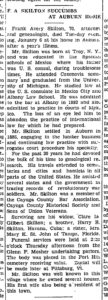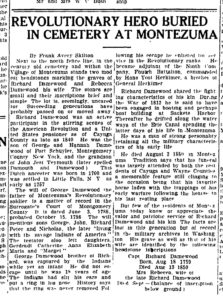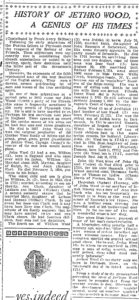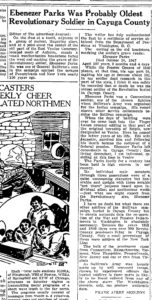Frank Avery Skilton died in 1931, and it is likely few of you have heard of him. And, he was not a resident of Port Byron or Mentz. So why I am writing about him? Well, his name kept coming up as I searched for ancestors to add to the Port Byron family tree. He fist popped up as a shirt-tail relative to the Hadger, Gutchess, Spaulding, and Root families as he married Florence Hadger in 1887. Although the Hadger name is a Port Byron name, this branch of the family tree had moved to Auburn, and that is likely where Florence met Frank.
More importantly to us today is that he was a man with the means and time to conduct genealogical searches in a time when that was the pursuit of the “well to do”. The opening paragraph of his obituary notes that he was a “attorney and genealogist.”
One of his passions in the later phases of his life was to travel the land searching for the graves of soldiers of the Revolutionary War. When he was doing this Florence had passed he he had married his second wife, Clara Gilbert Skilton. (Clara was a cousin of his.) During this time, Clara served as the chair of the Committee of Revolutionary War graves for the Owasco chapter of the Daughters of the American Revolution. In 1925 Frank wrote an article for the Port Byron Chronicle telling the story of Richard Damewood of Montezuma, a soldier who died in 1850 and was largely forgotten.
After being found by a community work crew in 1997, research led back to Frank’s article and that led to the grave being marked with a Pomeroy funded historic marker.
Frank came from a family of genealogists. His grandfather, Dr. Avery J. Skilton, was a noted researcher and is given great credit for the completion of the Steele Family history. (Avery’s mother was Chloe Steele.) And lest you think me running too far astray, the Kasson and Spalding families of Port Byron are related to the Steele clan. Thanks to Dr, Skilton they can trace their families back to 1624 and the arrival of the family to America. Frank’s father carried on the interest in genealogy and passed it along to Frank and his siblings.
A lot of the research and compiling of the Steele tree was completed prior to his death in 1858, and that alone is worth a moment of consideration. In our internet world, it is difficult to think that in the “old days” the family researcher had to carry out their work by making actual visits to court houses, cemeteries, next of kin and using the mail to request information from churches, local governments, and family members. The foreward to the Steele history notes that the researcher ran up against apathy, indifference, people who wanted money for information, and those who wanted to see their name in print. At least we can say that hasn’t changed!
In searching Frank, I found a letter addressed to Emily Howland that almost was pleading for information on the family of Isaac Wood. (I am not quite sure who Issac was but Jethro Wood, the inventor of the cast iron plow was married to a Howland.) Apparently, Emily had been indifferent to Frank’s questions, and she was the gatekeeper to finding what he desired. In 1924 Frank wrote an article for Auburn’s Advertiser-Journal about the Last Will and Testament of Jethro Wood and later published the “History of Jethro Wood, a Genius of His Times.” In the article it says that Jethro was buried in the Howland family plot, so I can only think that his letter to Emily had something to do with this book.
Frank frequently used the newspapers to search or relate information. A letter to the editor might say that he was seeking information about deceased family members. The Port Byron Chronicle ran a few of these letters. The Chronicle also carried articles from Frank telling about his discoveries such as when he wrote about Ebenezer Parks of East Venice who lived to be 107 years old and died in 1847. Finding these little tidbits of info today is pure gold for the desktop researcher who might miss such finds or not be able to read the weathered headstones.
In addition to all his genealogical work, Frank had a fascinating life. Frank was born in 1860 and his father was a surgeon in the Union Army. His mother, Harriet Euphrasia Ingersol, served as a nurse in a small pox ward in Washington DC during that period. Later in the war the family moved to New Orleans where Dr. Skilton was the Surgeon In Chief of the Cavalry. And then the family moved to Mexico and served as Consul under President Grant. In an odd family tragedy, Harriet’s sister was killed by her own daughter in a murder suicide in San Francisco, and there is so much more to this family. It is surprising that so little has been written about them.
The Skilton Family records are now housed at Cornell University.




